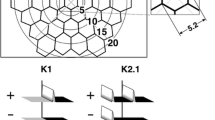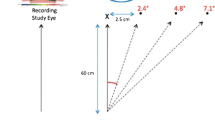Abstract
Purpose
To investigate the effect of unsteady fixation on the multifocal electroretinogram (mfERG) measurement in normal subjects.
Methods
The mfERGs of 20 subjects with normal vision (mean age=23.5 years) were recorded with different levels of voluntary eye movements made to mimic unsteady fixation. Subjects were required to move their fixation regularly every 2 s between the center and the ends of a fixation cross, so that 51.2% of the time fixation was at the center and 12.2% of the time it was at each end of the fixation cross. Four different conditions were performed: central fixation (without voluntary eye movements) and with 2°, 4° and 6° magnitude of unsteady fixation. First-order kernel mfERG findings are presented.
Results
Analysis of the ring responses indicated that the central mfERG amplitude was most affected by unsteady fixation. There was significantly reduced amplitude for 4° unsteady fixation and as expected, this reduction became larger with 6° unstable fixation. However, there was no significant effect on the center hexagon amplitude for 2° unsteady fixation. The amplitudes of the ring-2 responses were only affected in the 6° unsteady fixation condition. No significant change in implicit time was found for any level of unsteady fixation.
Conclusion
These results suggest that mfERG amplitude is not substantially affected if fixation is maintained within the central stimulus hexagon. We conclude that, for patients with poor fixation, the accuracy of mfERG results may be difficult to interpret and the use of a fixation-monitoring system is desirable for ideal measurement. The depth of depression at the blind spot area may be another useful parameter to interpret the accuracy of mfERG results in patients with poor fixation.








Similar content being viewed by others
References
Chan HH, Brown B (2000) Pilot study of the multifocal electroretinogram in ocular hypertension. Br J Ophthalmol 84:1147–1153
Chan HL, Brown B (1998) Investigation of retinitis pigmentosa using the multifocal electroretinogram. Ophthalmic Physiol Opt 18:335–350
Chan HL, Brown B (1999) Multifocal ERG changes in glaucoma. Ophthalmic Physiol Opt 19:306–316
Chisholm JA, Keating D, Parks S, Evans AL (2001) The impact of fixation on the multifocal electroretinogram. Doc Ophthalmol 102:131–139
Chu HW, Chan HL, Brown B (2006) Glaucoma detection is facilitated by luminance modulation of the global flash multifocal electroretinogram (mfERG). Invest Ophthalmol Vis Sci 47:929–937
Curcio CA, Sloan KR, Kalina RE, Hendrickson AE (1990) Human photoreceptor topography. J Comp Neurol 292:497–523
Felius J, Hood DC, Swanson WH (1997) Photopic temporal processing in patients with retinitis pigmentosa studied with the multi-focal ERG and psychophysical techniques. Vision science and its applications, 1997 OSA Technical Digest Series, vol 1, Washington, D.C. Optical Society of America 1:276–279
Felius J, Swanson WH (1999) Photopic temporal processing in retinitis pigmentosa. Invest Ophthalmol Vis Sci 40:2932–2944
Fortune B, Bearse MA Jr, Cioffi GA, Johnson CA (2002) Selective loss of an oscillatory component from temporal retinal multifocal ERG responses in glaucoma. Invest Ophthalmol Vis Sci 43:2638–2647
Hasegawa S, Takagi M, Usui T, Takada R, Abe H (2000) Waveform changes of the first-order multifocal electroretinogram in patients with glaucoma. Invest Ophthalmol Vis Sci 41:1597–1603
Heinemann-Vernaleken B, Palmowski AM, Allgayer R, Ruprecht KW (2001) Comparison of different high resolution multifocal electroretinogram recordings in patients with age-related maculopathy. Graefe's Arch Clin Exp Ophthalmol 239:556–561
Hood DC, Frishman LJ, Saszik S, Viswanathan S (2002) Retinal origins of the primate multifocal ERG: implications for the human response. Invest Ophthalmol Vis Sci 43:1673–1685
Hood DC, Holopigian K, Greenstein V, Seiple W, Li J, Sutter EE, Carr RE (1997) A comparison of visual field loss to multi-focal ERG changes in patients with RP. Vision science and its applications, 1997 OSA Technical Digest Series, vol 1, Washington, D.C. Optical Society of America 1:272–275
Hood DC, Holopigian K, Greenstein V, Seiple W, Li J, Sutter EE, Carr RE (1998) Assessment of local retinal function in patients with retinitis pigmentosa using the multi-focal ERG technique. Vision Res 38:163–179
Hood DC, Li J (1997) A technique for measuring individual multifocal ERG records. In: Yager D (ed) Non-invasive assessment of the visual system. Trends in optics and photonics, vol 11, Washington, D.C. Optical Society of America 11:33–41
Hood DC, Odel JG, Chen CS, Winn BJ (2003) The multifocal electroretinogram. J Neuroophthalmol 23:225–235
Huang S, Wu D, Jiang F, Ma J, Wu L, Liang J, Luo G (2000) The multifocal electroretinogram in age-related maculopathies. Doc Ophthalmol 101:115–124
Jiang F, Huang S, Luo G, Wu D, Liang J, Liu C (2001) The measurement of multifocal electroretinography. Yan Ke Xue Bao 17:217–219
Jurklies B, Weismann M, Husing J, Sutter EE, Bornfeld N (2002) Monitoring retinal function in neovascular maculopathy using multifocal electroretinography—early and long-term correlation with clinical findings. Graefe's Arch Clin Exp Ophthalmol 240:244–264
Keating D, Parks S, Evans A (2000) Technical aspects of multifocal ERG recording. Doc Ophthalmol 100:77–98
Kondo M, Miyake Y, Horiguchi M, Suzuki S, Tanikawa A (1995) Clinical evaluation of multifocal electroretinogram. Invest Ophthalmol Vis Sci 36:2146–2150
Li J, Tso MO, Lam TT (2001) Reduced amplitude and delayed latency in foveal response of multifocal electroretinogram in early age related macular degeneration. Br J Ophthalmol 85:287–290
Marmor MF, Hood DC, Keating D, Kondo M, Seeliger MW, Miyake Y (2003) Guidelines for basic multifocal electroretinography (mfERG). Doc Ophthalmol 106:105–115
Menz M, Sutter E (2004) The effect of fixation instability on the multifocal VEP. Doc Ophthalmol 109:147–156
Palmowski AM, Allgayer R, Heinemann-Vernaleken B, Ruprecht KW (2002) Multifocal electroretinogram with a multiflash stimulation technique in open-angle glaucoma. Ophthalmic Res 34:83–89
Palmowski AM, Sutter EE, Bearse MA Jr, Fung W (1999) Multifocal electroretinogram (MF-ERG) in diagnosis of macular changes. Example: senile macular degeneration. Ophthalmologe 96:166–173
Poloschek CM, Rupp V, Krastel H, Holz FG (2003) Multifocal ERG recording with simultaneous fundus monitoring using a confocal scanning laser ophthalmoscope. Eye 17:159–166
Rudolph G, Kalpadakis P, Bechmann M, Haritoglou C, Kampik A (2003) Scanning laser ophthalmoscope-evoked multifocal ERG (SLO-mfERG) in patients with macular holes and normal individuals. Eye 17:801–808
Sasoh M, Yoshida S, Kuze M, Uji Y (1998) The multifocal electroretinogram in retinal detachment. Doc Ophthalmol 94:239–252
Schuchard RA, Naseer S, de Castro K (1999) Characteristics of AMD patients with low vision receiving visual rehabilitation. J Rehabil Res Dev 36:294–302
Seeliger M, Kretschmann U, Apfelstedt-Sylla E, Ruther K, Zrenner E (1998) Multifocal electroretinography in retinitis pigmentosa. Am J Ophthalmol 125:214–226
Seeliger MW, Kretschmann UH, Apfelstedt-Sylla E, Zrenner E (1998) Implicit time topography of multifocal electroretinograms. Invest Ophthalmol Vis Sci 39:718–723
Sutter EE, Tran D (1992) The field topography of ERG components in man-I. The photopic luminance response. Vision Res 32:433–446
Vrabec TR, Affel EL, Gaughan JP, Foroozan R, Tennant MT, Klancnik JM Jr, Jordan CS, Savino PJ (2004) Voluntary suppression of the multifocal electroretinogram. Ophthalmology 111:169–176
Acknowledgements
This study was supported by the Associated Fund (Research Postgraduate) from The Hong Kong Polytechnic University and the Competitive Earmark Research Grant (PolyU 5384/04M) from The Research Grants Committee of the Hong Kong SAR.
Author information
Authors and Affiliations
Corresponding author
Rights and permissions
About this article
Cite this article
Chu, P.H.W., Chan, H.H.L. & Leat, S.J. Effects of unsteady fixation on multifocal electroretinogram (mfERG). Graefe's Arch Clin Exp Ophthalmo 244, 1273–1282 (2006). https://doi.org/10.1007/s00417-006-0304-8
Received:
Revised:
Accepted:
Published:
Issue Date:
DOI: https://doi.org/10.1007/s00417-006-0304-8




